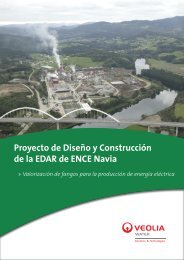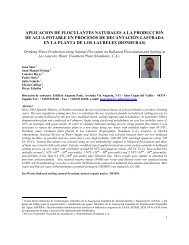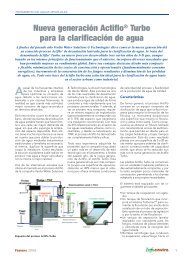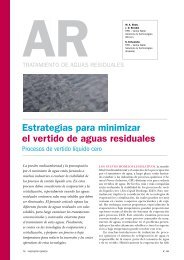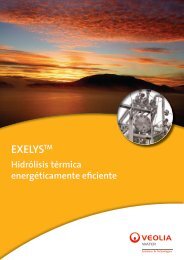PURE LABWATER GUIDE - Veolia
PURE LABWATER GUIDE - Veolia
PURE LABWATER GUIDE - Veolia
You also want an ePaper? Increase the reach of your titles
YUMPU automatically turns print PDFs into web optimized ePapers that Google loves.
Instrument feed water<br />
Instrument feed water is intended for the internal rinsing, dilution and water<br />
bath functions of automated instruments. Use of CLRW for this application<br />
must be confirmed with the manufacturer of a specific instrument and water of<br />
this specification must be used.<br />
CLSI emphasises ensuring that laboratory water is suitable for its use. The water<br />
must be validated as fit for purpose for each laboratory procedure in which it is<br />
to be used. The system producing purified water must also be validated. Regular<br />
monitoring, trending and documentation of appropriate parameters must<br />
be carried out to verify that water purification technologies and systems are<br />
working effectively. Procedures must be established for system maintenance.<br />
Only one grade, Clinical Laboratory Reagent Water (CLRW) is defined in detail.<br />
Other grades are described in relation to their application and user-defined<br />
in detail.<br />
Specifications for CLRW<br />
Ionic Impurities – Resistivity 10 MΩ-cm<br />
Organic Impurities – TOC < 500 ppb<br />
Microbiological Impurities Total heterotrophic plate count < 10 CFU/ml*<br />
Particle Content – In-line 0.2 μm filter or finer near the output stage<br />
*epifluorescence and endotoxin testing are optional to provide extra information<br />
International Organization for Standardization specification for<br />
water for laboratory use ISO 3696: 1987<br />
This standard covers three grades of water as follows:<br />
Grade 1<br />
Essentially free from dissolved or colloidal ionic and organic contaminants. It is<br />
suitable for the most stringent analytical requirements including those of high<br />
performance liquid chromatography (HPLC). It should be produced by further<br />
treatment of grade 2 water, for example by reverse osmosis or ion exchange,<br />
followed by filtration through a membrane filter of pore size 0.2 μm to remove<br />
particle matter, or re-distillation from a fused silica apparatus.<br />
Grade 2<br />
Very low inorganic, organic or colloidal contaminants and suitable for sensitive<br />
analytical purposes including atomic absorption spectrometry (AAS) and the<br />
determination of constituents in trace quantities. Can be produced by multiple<br />
distillation, ion exchange or reverse osmosis followed by distillation.<br />
Grade 3<br />
Purified water standards<br />
Suitable for most laboratory wet chemistry work and preparation of reagent<br />
solutions. Can be produced by single distillation, ion exchange or reverse<br />
osmosis. Unless otherwise specified, it should be used for ordinary analytical<br />
work.<br />
Parameter Grade 1 Grade 2 Grade 3<br />
pH value at 25ºC inclusive range N/A N/A 5.0 to 7.5<br />
Electrical conductivity µS/cm 25ºC, max. 0.1 1.0 5.0<br />
Oxidizable matter Oxygen (O 2 ) content<br />
mg/l max.<br />
Absorbance at 254 nm and 1cm optical<br />
path length, absorbance units, max.<br />
Residue after evaporation on heating at<br />
110ºC mg/kg, max.<br />
N/A 0.08 0.4<br />
0.001 0.01 Not specified<br />
N/A 1 2<br />
Silica (SiO 2 ) content mg/l, max. 0.01 0.02 Not specified<br />
69-70<br />
Water purification overview



